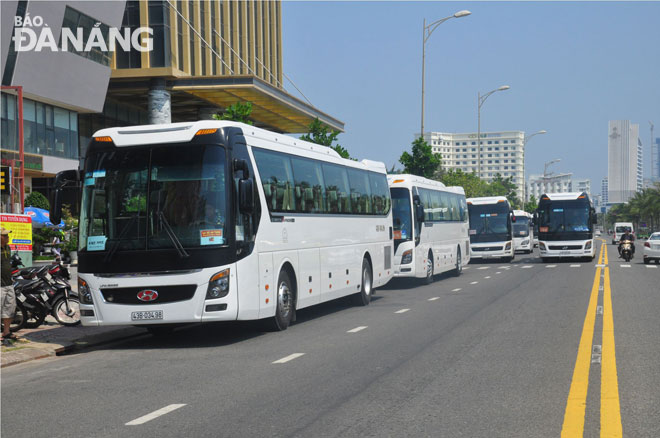Ban on 30-seater coaches from inner-city needs to be taken into consideration
The Da Nang People’s Committee has already issued regulations on the operation of over 30-seater passenger coaches, except for buses, in the city’s inner areas, with the aim of considerably reducing the alarming traffic congestion, an issue of deep concern facing the city. However, there have been some public opinions which appealed for a need to take the implementation of the new regulations into careful consideration.
 |
| It is necessary to take the ban on over 30-seater coaches from the inner city into careful consideration. |
Amongst the city’s traffic gridlock hotspots are some sections of downtown streets. During rush hours, a large number of vehicles including cars, tourist coaches, taxis, and motorcycles are caught in traffic gridlock, which sparks anger amongst road users.
According to Mr Le Van Trung, the Director of the municipal Department of Transport, traffic congestion usually occurs during rush hours, especially during 6.45am - 7.45am, 11.00am - 12.00pm, and 4.00pm - 6.30pm daily, on main routes connecting inner with suburb areas.
It is also worth mentioning that a growing number of flight arrivals and departures are blamed for the intensified traffic gridlock facing the city centre during peak hours at noon and in the afternoon.
Besides, the city’s tourism industry has developed strongly in recent times with an average growth rate of 14.84%, whilst the Hai Chau and Thanh Khe districts have witnessed a sharp rise in the number of accommodation establishments.
In reality, many travel agencies usually use 30-seater coaches to take tourists to popular attractions located in inner areas, hereby causing more traffic pressure here.
In an effort to alleviate this matter, as suggested by the Department of Transport, the municipal administration has given a ban on over 30-seater coaches and trucks from some certain streets during 10.30am - 12.00pm and 4.30pm - 7.00pm daily. The banned streets are those inside the Nguyen Tat Thanh-Ly Thai Tong-Hoang Thi Loan-Dien Bien Phu-Nguyen Tri Phuong-Nguyen Huu Tho-Xo Viet Nghe Tinh-2 September-Bach Dang-3 February-Nguyen Tat Thanh margin route.
From now until 31 August, relevant agencies are promoting the publicity and asking vehicle drivers to strictly comply with the new traffic regulations. Administrative fines will be officially imposed on violations from 1 September onwards.
 |
| In response to the new regulations, local travel agencies must make certain adjustments to their tourist services |
In his perspectives on the new regulations, Mr Huynh Dinh Quoc Thien, the Director of the Museum of Da Nang, pointed out to the fact that tourists usually take their city-tours at around 9.00am, and visit the museum from 10.00am until the afternoon. It is reported that the number of visitors to the museum during the above-mentioned restricted time periods accounts for about 25 - 30% of the total figure.
Actually, the new regulations are hindering tourists from visiting this popular attraction. As a result, the site is likely to see a sharp decline in visitor arrivals in the coming time. Therefore, it is an urgent need for relevant local agencies to take the regulations into more careful consideration.
Meanwhile, Mr Le Thai Bao Long, the Director of the Truong Sa tourism company, said, aside from the above-mentioned regulations, it is a good ideas to construct more parking areas in the city centre and promote the use of such public transportation means as buses, electric cars and bicycles in the coming time.
According to the city’s Vehicle Registration Centre, by the end of last year, there had been 3,961 passenger coaches operating in the city, accounting for 4.98% of the total vehicles. Of this figure, 751 were over 30-seater coaches, whist the remainder were under 30-seater ones.